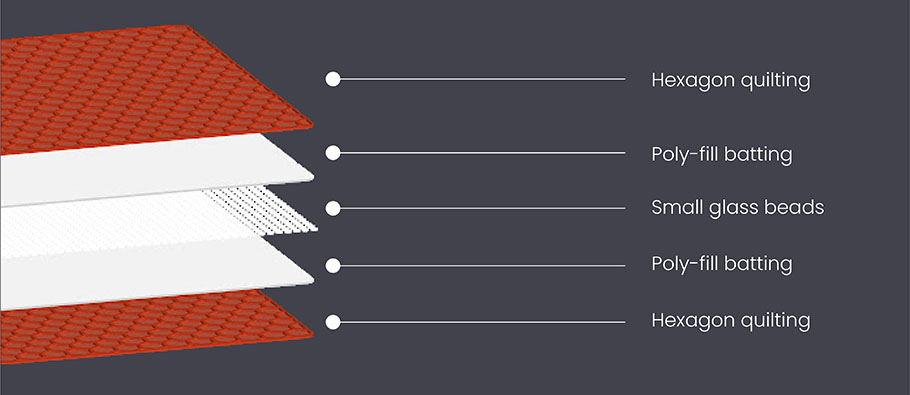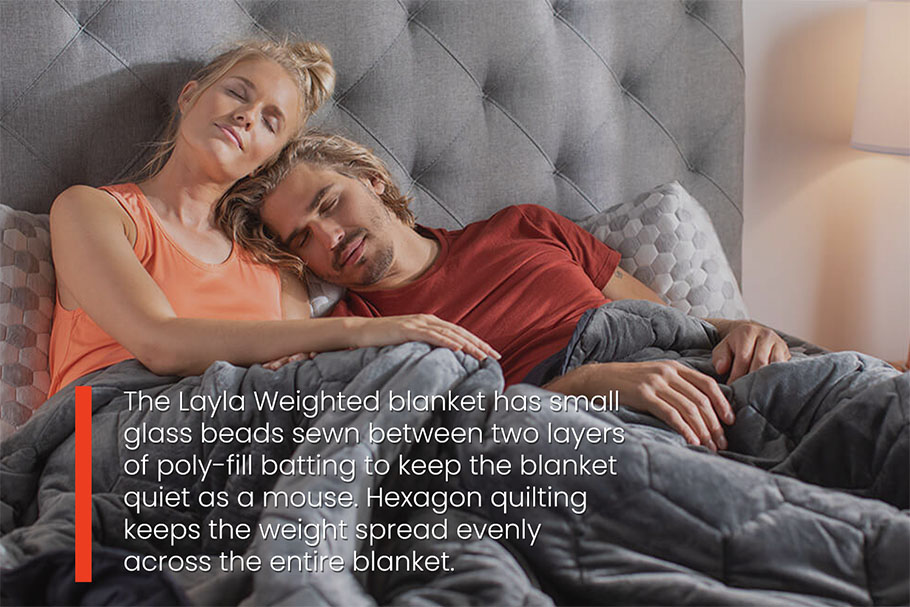What Are Weighted Blankets Made Of?

Well, we’ve compiled a helpful guide to assist you in your search for the perfect weighted blanket. If you’re wondering, “what are weighted blankets made of?” you’re in the right place. Keep reading to learn more about how these carefully engineered blankets can enhance your life by reading from start to finish or using the table of contents to navigate throughout the post.
- What Are Weighted Blankets?
- How Are Weighted Blankets Made?
- What Is a Weighted Blanket Made Of?
- Weighted Blanket Filler Options
- What Is a Weighted Blanket Made of on the Outside?
- How to Wash Your Weighted Blanket
- The Layla Weighted Blanket
- Conclusion: What’s Inside a Weighted Blanket?

What Are Weighted Blankets?
Weighted blankets are crafted to help relieve stress and deliver a sense of well-being and calm for the user. It accomplishes these feel-good effects by offering a comforting layer of pressure to the body.
Weighted blankets work by mimicking deep touch pressure therapy, also known as DTP, which helps increase the number of endorphins in your body. These endorphins are the same hormones responsible for giving you a “runners’ high.” DTP also helps release positive neurotransmitters like dopamine and serotonin, bringing you an overall sense of peace and calmness. So, instead of going to the spa for a day, you can just slip under a weighted blanket for that relaxed feeling you want – minus the sliced cucumbers and face masks.
Although it’s possible to enjoy the effects of DTP with manual hand pressure, weighted blankets are a much more effective way to take advantage of DTP – especially if you sleep alone and don’t have access to a 24/7 occupational or massage therapist when you’re stressed.
These specially crafted blankets can soothe anxiety and stress, help you fall asleep more easily, ease restless leg syndrome, calm sensory processing disorders, and diminish symptoms of ADHD.
How Are Weighted Blankets Made?
When you pick up a weighted blanket, you’ll notice they’re heavier than your standard blankets. So, how are they made, and what are weighted blankets made of? Weighted blankets consist of an exterior fabric, typically made from a soft, plush material like cotton, fleece, or linen. Inside a weighted blanket, you can find a wide range of materials, such as glass beads, which are sewn into pockets to prevent them from bunching and distributing unevenly.
The added weight of a weighted blanket comes with a wide range of proven health benefits due to its deep touch pressure properties. In addition to soothing anxiety and stress, some benefits of weighted blankets include:
- Improving sleep quality
- Reducing symptoms of restless leg syndrome
- Assisting people with sensory processing disorders
- Limiting symptoms associated with PTSD
These are just some of the many benefits of weighted blankets. Now that you know the many reasons why to get a weighted blanket and how they can help you get the slumber you deserve, let’s dive into how they’re made and the materials inside of them that are responsible for these crucial benefits.
What Is a Weighted Blanket Made Of?
As you might imagine, a weighted blanket is filled with a substance that’s – wait for it – weighted. But depending on the kind of weighted blanket you choose, your blanket may be filled with plastic pellets, steel beads, glass beads, and a variety of other popular fillers. Below, we’ll dive into the different kinds of materials you’ll see in weighted blankets, and which one might be best for you.
Weighted Blanket Filler Options
There are many weighted blanket filler options, each distributing weight differently. Refer to our weighted blanket weight guide to determine how heavy your weighted blanket should be. Here are the most popular commercial and DIY weighted blanket fillers you’ll see as you search for your own weighted blanket:
Glass Beads
One of the top blanket fillers for weighted blankets is glass beads. Micro glass beads are smooth to the touch and offer more weight compared to other filler options like sand, organic materials, and plastic poly pellets, which means fewer beads will be needed to construct the blanket. The benefit? Less bulk. With fewer units of glass beads, your weighted blanket will be less hefty, which is great for sleepers with sensory and auditory sensitivities. At Layla Sleep, our weighted blanket is constructed with micro glass beads that are sewn between two layers of poly-fill batting to keep the blanket as quiet as a mouse.
Plastic Poly Pellets
Commercially made blankets are often filled with plastic pellets, which are formed into small, round beads. They’re hypoallergenic, easy to clean, and durable.
But plastic pellets also have significant drawbacks. In addition to contributing to plastic pollution, they can make your weighted blanket feel bumpy and uncomfortable. This is especially problematic for people who are using weighted blankets to soothe sensory issues.
Organic Materials
Rice, beans, grains, and corn aren’t just what’s for dinner, they can also comprise the filling in weighted blankets. These organic filler materials tend to be budget-friendly but come with significant negatives. Because they’re organic materials, they’re much more likely to degrade over time, give off unpleasant odors, attract insects, and may even promote mildew growth.
And, because the material is organic, you can’t wash them, unless you want a soggy bean or corn blanket instead of a weighted blanket (no thanks).
Pebbles or stones
Believe it or not, pebbles can be used in weighted blankets as a cost-effective solution filler. But, if you choose to fill your blanket with stones you find on the ground, it’s important to note what Mom and Dad might have warned you about: you get what you pay for. And that warning certainly applies in this case.
Pebbles vary in size, so your blanket will have inconsistent texture and weight, making it less effective overall. For people with sensory issues, the lack of consistency can be especially bothersome. Nobody wants to wrap themselves up in a blanket burrito, feeling a rock poking into their back.
Sand
Although sand is one of the cheapest filler options on this list, it comes with serious drawbacks. Sand is incredibly difficult to distribute over the surface area of your blanket evenly, which can result in large, uncomfortable mounds that are difficult to spread out again. Sand can also seep out through blanket stitching, and nobody wants to wake up to a bunch of loose sand in their bed. Plus, if you accidentally spill water or any other liquid on your blanket, good luck. Sand expands when it’s wet, making it incredibly difficult to dry – especially when it’s already inside your blanket.
Leave the sand where it belongs: at the beach.
Steel Beads
Steel beads offer a heavier and consistent weight, making them a promising filler material. Plus, steel beads are typically heat-treated, making them easy to clean. Unfortunately, steel beads are often larger in size, which means unsightly and uncomfortable lumps and bumps interrupting your calming weighted blanket experience. In addition to their size, steel beads might also be louder, with an unmistakable metallic clicking.
What Is a Weighted Blanket Made of on the Outside?
We know that the inside of a weighted blanket can be made of glass beads, plastic pellets, sand, rocks, pebbles, and steel beads, but what are weighted blankets made out of on the outside? In order to keep its filling in place, weighted blankets can be constructed from a wide range of fabrics, such as:
- Cotton
- Bamboo
- Flannel
- Polyester
In addition to the outer fabric, most weighted blankets will also have some type of filler to make the blanket warmer and comfier, such as cotton. When it comes to choosing a fabric type, it depends on your personal preferences. For example, cotton is a natural fiber that’s known for its hypoallergenic properties and easy care instructions, while polyester is known for its durability, but isn’t as breathable as natural fibers.
How to Wash Your Weighted Blanket
Maybe you already have a weighted blanket. If that’s the case, you might wonder how you can actually wash a weighted blanket. Well, as we mentioned above, if your weighted blanket is filled with an organic material, you’re out of luck. Water mixed with uncooked grains, beans, rice, and corn in your weighted blanket will make a soup, and not the delicious kind you were hoping for.
In fact, many weighted blankets are not washable. If you have a sand-filled weighted blanket, avoid washing it because the sand in the blanket will expand. When the sand inside your blanket is wet, it’s extremely hard to fully dry it out.
If you have pebbles as the filler in your weighted blanket, it’s also smart to avoid the washing machine. The varying pebble weights could tear your blanket, setting pebbles loose in your machine and potentially damaging the inside of your machine (and probably all while making a terrible sound, too).
With these filling types, it’s a good idea to spot-clean. Never soak your weighted blanket if you can avoid it.
Steel beads, glass beads, and poly beads have the best chance of being machine washable, depending on the outside fabric and overall construction. If you’re unsure of whether your blanket is washable, it’s best to err on the side of caution and avoid putting it in your washing machine. After all, you don’t want to clean up a mess of beads from your dryer or washing machine in your effort to clean your blanket.
If you decide to invest in a Layla Weighted Blanket as your choice, you’ve got the easy way out. The instructions for washing a Layla Weighted Blanket are very simple:
- Wash on cold
- Set to gentle
- Do not bleach or iron
- Tumble dry low
Our weighted blankets are designed to be life-friendly, so you don’t have to worry about spilling something on your blanket and fretting about getting it out using a spot treatment. You can simply throw it into the washing machine, worry-free.

The Layla Weighted Blanket
Buying a weighted blanket can be a challenge, especially if you don’t know what to look for. Luckily, the Layla Weighted Blanket isn’t just a bed accessory; it’s a tool you can use to whisk you away to a better night of sleep. The outside construction of the blanket offers two sides of dreamy comfort. On one side, you’ll enjoy plush, mink-like softness. And on the other side, you’ll find clean, soft cotton with a premium 300 thread count. Complemented by the hexagon pocket stitching, this blanket is designed to provide you with reliable use, night after night.
Inside your Layla Weighted Blanket, you’ll find micro glass beads sewn between layers of batting. For you, this means an ultra-quiet weighted blanket with weight evenly spread across. Plus, it’s completely washable, so you don’t have to worry about your breakfast-in-bed habit creating a headache-inducing mess. A night sleeping with the Layla Weighted Blanket is like getting a hug from your favorite person, all night long.
Conclusion: What’s Inside a Weighted Blanket?
One of the top questions for many sleepers is: what are weighted blankets made of? Throughout this guide, we found that weighted blankets can be made of glass beads, sand, rocks, pebbles, steel beads, and more. Although there are other kinds of weighted blankets out there with different kinds of fillings available, we believe that our glass-bead filled blanket is the stuff dreams are made of.
Quiet, smooth, and calming, the Layla Weighted Blanket is perfect for calming a restless mind and body. Plus, Layla Sleep stands behind our Layla Weighted Blanket wholeheartedly. That’s why we offer a 30-Night Trial and Return Policy in case you don’t love it. But we’re pretty sure you will.







